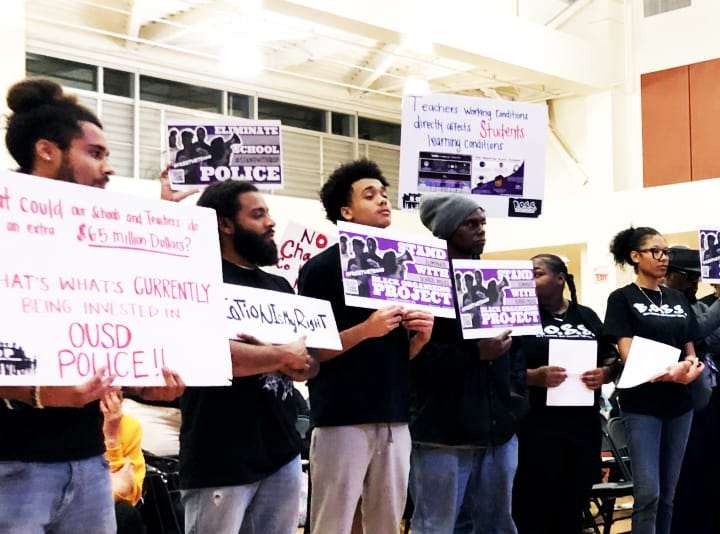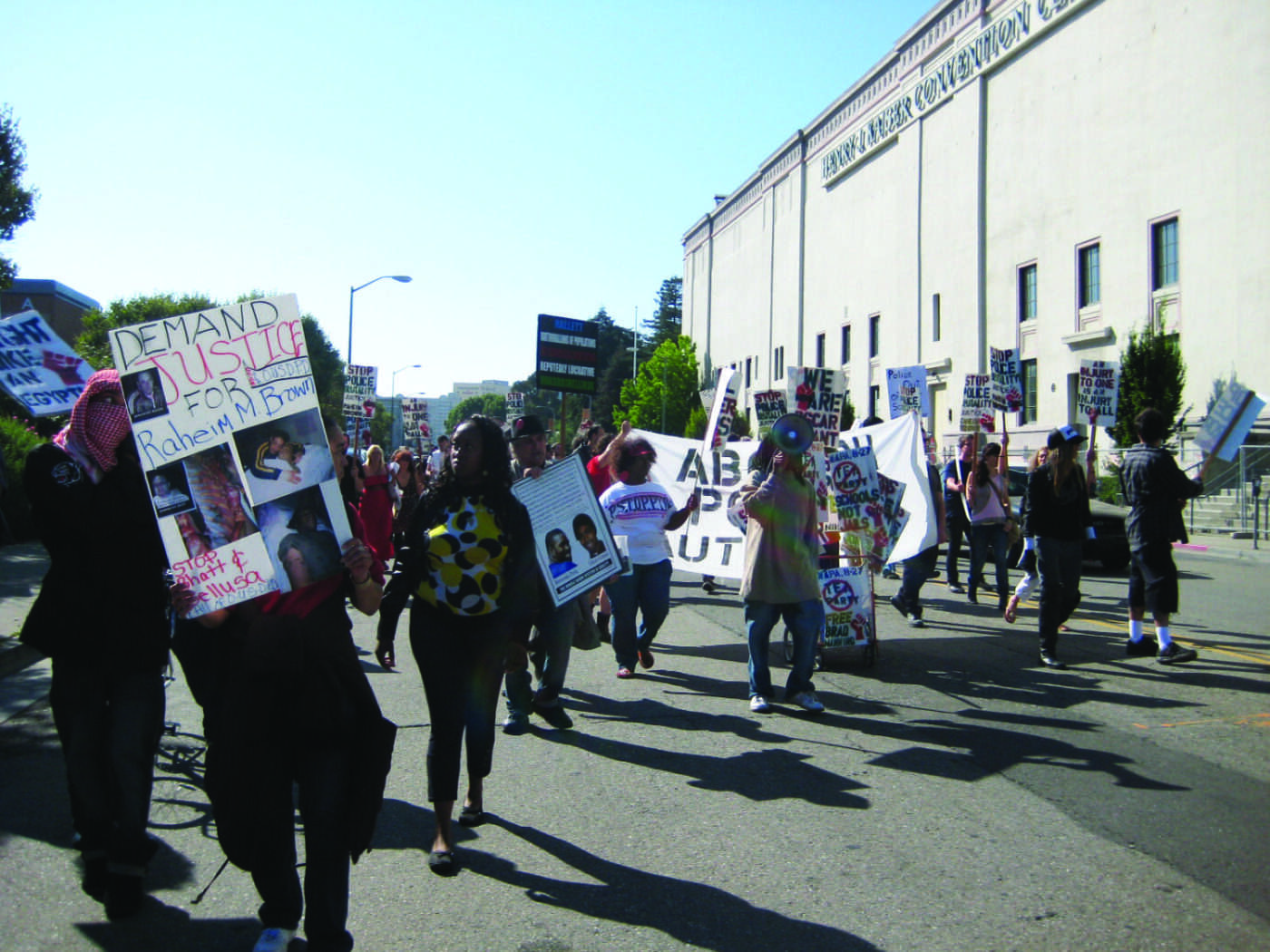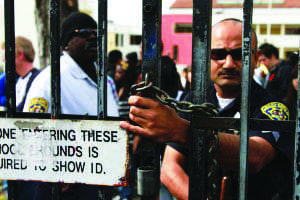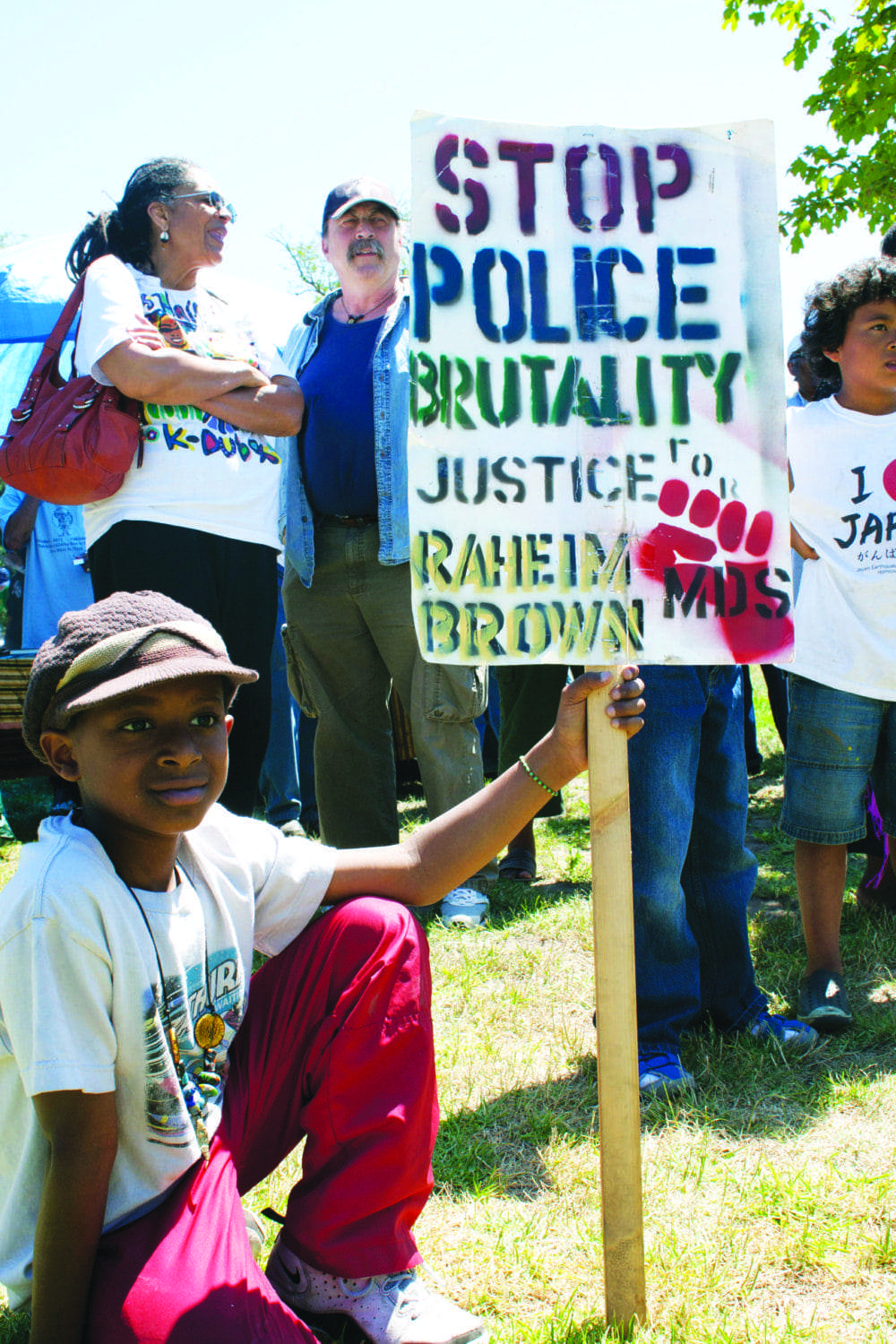Uncovering the history of school policing in Oakland to move our vision for police free schools

by Jackie Byers and Manuel Criollo
This Wednesday, June 24, the Oakland Unified School District Board of Education directors will be voting on the George Floyd Resolution calling for police-free schools in the Oakland Unified School District by eliminating the Oakland School Police Department.
We urge every School Board member to stand with the Black Organizing Project and vote yes on this unprecedented and path breaking resolution to eliminate Oakland’s School Police Department. One of the most important reasons is the little known history of how policing came into Oakland’s schools and the community’s constant resistance.

The 1950s: School and police cooperation as the foundation for police in schools
Today people tend to assume police were placed in schools in response to the first school shooting at Columbine High School in 1999. But in reality, police presence in Oakland schools has a long, racist past that needs to be shed and undone. The origin of police in schools is rooted in a racist ideological reaction to the mass migration of Southern Black families to Oakland in the 1940s and 1950s.
The post-World War II mass migration of Black Southern families to the Bay Area – looking for greater job opportunities and life expectancies – quickly shifted the demographic makeup of Oakland and its schools. The consequences of a racist backlash to the migration of Black families was immediate and severe.
Oakland city, schools and policing officials moved towards an educational model that embraced assumed Black deficiencies and juvenile delinquency. Historian Donna Murch has documented how this pathologizing perception of Black youth was deliberately constructed so that they became defined as “a social problem at best, and as a criminal presence at worst.” It was this time that the first “juvenile control coordinator” position was created and schools began creating the earliest systems of surveillance and tracking of so-called “troublemakers” in schools.
Throughout this time, white residents of Oakland and city officials began to form integrated government services that fused Oakland police, the county probation office and the California Youth Authority with education, welfare and health services. The strategy was to contain, segregate, track and criminalize these of the newly arrived Black youth with schools as the epicenter.
Police regularly began to monitor and arrest students who were subjectively deemed as “delinquent” by school staff. Youth were then funneled into the criminal justice system in order to receive any type of social services – probation officers, judges and child guidance clinics began monitoring youth based on the biases of school staff. By 1957, Oakland School District had established its own school security force as the hub of this strategy.
Many of the Black youth who were targeted and arrested at school went on to become founding members and leaders within the Black Panther Party. By his own account, Huey P. Newton was suspended from Oakland schools 30 to 40 times and eventually incarcerated at the California Youth Authority (now the Division of Juvenile Justice) where he first met several other key BPP members.
The 1960s and 1970s: Reacting to the Black Power period with a rise of harsh discipline and policing in schools

“From all indications, the upcoming confrontation between large numbers of infuriated Oakland parents and the adamant Oakland School Board looms as a major battle over who actually controls Oakland’s schools. It will be a battle which brings to the forefront the question of whether or not school corridors are an appropriate place for police patrols.” – “Will Police Patrol Oakland Schools?” Black Panther newspaper, Oct. 13, 1973
As the Civil Rights and Black Power movements gained prominence and power, police in schools and zero tolerance responses were put in place to contain and suppress their organizing. The Black Panther Party for Self-Defense emerged from the streets of Oakland in 1967 to build one of the most powerful and visionary forces for Black Liberation.
The Black Panther Party organizing and political vision centered on police abolition, Black liberatory education, Black self-determination and an insistence on community control of our institutions, schools and future. In 1969, the Oakland Public School Board revamped their student discipline code to emphasize greater punishment and restrictive policies, including increased cooperation with the Oakland Police Department.
Oakland Police were empowered to enter, detain, question and arrest students at school at this time. Measures that intensified the punishment and suspension regimes were also introduced for “willful defiance,” profanity and defiance toward school personnel.
In 1973, Oakland received a Criminal Justice Planning Board Grant to integrate even more school, police, probation and juvenile court systems. That same year, Oakland Public School officials unleashed a 150 personnel “mob squad” of police and security guards on seven junior and senior high schools to curb student truancy and maintain order at a cost of $1.5 million. These moves led to citywide protests and rallies led by the Black community with the support of the Black Panther Party.
For instance, the Coalition to Save Our Schools partnered with the Black Panther Party to fight implementation and funding directed to the “Coordinated Interagency Action Program for Reduction of Truancy, Vandalism and Violence in Select Urban Schools.” The Black Panther Party called this program the C.I.A (Coordinated Interagency Action), an entity developed by an all-White Alameda County Grand Jury report with recommendations for a district that at that time had over 65 percent Black student enrollment.
Federal, state and local police agencies responded with increased surveillance, suppression and criminalization of Black organizations, racial justice and student movements.
Against the national backdrop of school desegregation and calls for community control of schools by Black and Brown communities, racist forces in Oakland responded by ramping up school security guards, police officers and the criminal justice system to stem what school officials deemed as student disorder and criminality.
The 1980s: Gov. George Deukmejian and the pro-prison right push Oakland schools to permanently station police in schools

locks protesters out of a meeting at Fremont High
School on March 4, 2011. Shortly after the murder,
Bhatt was appointed chief of the OUSD police force
but quickly removed after public outcry. – Photo:
KALW
Oakland became a testing ground for rightwing, pro-prison and “tough on crime” proponents throughout the 1980s, much of which played out in the schools and in the building of an infrastructure of police presence in educational policy. During this period, Gov. George Deukmejian – the architect of the California Prison Industrial Complex – led an effort to permanently station police in schools by igniting rhetoric couched in school safety and student disorder fears.
Acting as the state attorney general, Deukmejian sued the Los Angeles Unified School District and the City of Los Angeles for “endangering” student lives in public schools. Though he ultimately lost the legal case, his inflaming rhetoric became the basis of the introduction of policies under the guise of safety in schools. This rhetoric founds its path to policy and implementation with the passage of California’s Proposition 8, “The Victims’ Bill of Rights,” in June 1982.
Supported by victims’ rights advocates and propelled by the rightwing prison and punishment expansion forces, Proposition 8 imposed mandatory minimums, longer prison sentences, and restricted court discretion and prior conviction penalties – the first of many prison expansion efforts in California. While sold as a “tough on crime” and “victims’ first” law, the drafters of Proposition 8 also created for the first time a “right” to school safety.
It reads, “All students and staff of public primary, elementary, junior high and senior high schools have the inalienable right to attend campuses which are safe, secure and peaceful.” This became the impetus of the legislation to legalize and deputize police in schools in the state.
Given the broad definition of “safety” in schools under this new state constitutional amendment, many school districts were left vulnerable to being sued and thus coerced to deputize their security as police officers or to contract with city police officers.
Proposition 8 was used by the conservative Pacific Legal Foundation and the National Center for School Safety, a Reagan administration-funded group, to sue Oakland Unified using broad language about the “right to safety in school, despite a lack of guidance on any enforcement mechanisms.” While community violence was playing out in the streets of Oakland, the Pacific Legal Foundation was focused on exploiting a case at school that involved the theft of a watch and an assault between two white students in the hillsides of Oakland.
At least 30 similar lawsuits under the “Victims Bill of Rights” were initiated throughout the state by tough-on-crime rightwing advocates. Among the districts facing such suits were the Los Angeles Unified School District, and districts in San Diego, Inglewood, Long Beach and San Bernardino.
Oakland Unified balked at the pressure to institute permanent police at school – both for financial and school climate considerations – and argued that, while their schools were experiencing episodes of real violence, they were not outside the norm of unpredictable acts. Siding with the Pacific Legal Foundation, in June 1986, Judge Richard Bartalini ordered Oakland school officials to submit a plan designed to guarantee the safety of students.
By the end of the year, under mounting pressure, the Oakland School District initiated armed and deputized police officers in the schools. While the case was ultimately overturned, by the time it reached the higher court approximately five years later, police were already fully entrenched on school grounds.

Our past shapes our future – our future is police free schools
It is time for OUSD to break with this long and embedded history of policing and criminalization of Black students, families and communities. Now, over 30 years of divestment, dislocation, gentrification and the mass incarceration of Black Oakland has resulted in the presence of police in every facet of Black life.
OUSD is complicit and explicitly participating in continuing this racist legacy. We at the Black Organizing Project reject this idea. Policies that maintain police in our schools only fortify educational racism and aggravate the already policed and militarized culture of our schools and communities.
We launched our Bettering Our Schools Campaign (BOSS) in response to the murder of Raheim Brown by an Oakland school police officer in 2011. In Oakland today, the closing of schools and declining student enrollment are pitting communities against each other and deepening rivalries between public and charter schools.
These trends are intertwined with the continued dislocation and displacement of the Black community from Oakland and the Bay Area. Destabilized schools foster an increasingly toxic climate – inside and outside the classroom – that pushes Black families out in tandem with increased housing costs and gentrification schemes.
Now, over 30 years of divestment, dislocation, gentrification and the mass incarceration of Black Oakland has resulted in the presence of police in every facet of Black life.
Nor can we ignore state and city budgets that continue to sacrifice education and social service programs to increase ever-growing policing and incarceration budgets. Black Oakland’s human rights crises are all interlinked: housing and gentrification, mass incarceration and the future of education. We can take a powerful step towards addressing these concerns by ending racialized policing in OUSD.
Over the past nine years, the Black Organizing Project has organized students, families and community members to provide OUSD leadership with countless personal testimonies, feedback from community forums and one-on-one meetings. We have provided abundant data demonstrating the disproportionate harms of the school-to-prison pipeline on students and families of color.
We have channeled the groundswell of protests and community outrage at the high profile police murders of Black men and women from Atlanta to Louisville to Oakland to Minneapolis into demands for dismantling OUSD’s school-to-prison pipeline.
The dismantling of Oakland School Police Department is urgent and will position Oakland, the district and the community for a monumental victory that will be felt and replicated across the country. In doing so, we will be supporting a movement against an increasingly toxic climate – inside and outside the classroom – that pushes Black families out of schools and makes it impossible for them to remain in their communities with increased criminalization, housing costs and gentrification development schemes.
OUSD has the information that it needs to act. The question is, will they take action?
This report was prepared by Black Organizing Project Executive Director Jackie Byers and Forward Change Lead Trainer Manuel Criollo for the Black Organizing Project Political Education Commission. They can be reached via Jasmine Williams at jwilliams@blackorganizingproject.org. Read the George Floyd Resolution, which is on the Oakland School Board’s agenda June 24 here: https://drive.google.com/file/d/1yKkYroVLeBKuepPmrdQNj3xSrPbn5BN_/view.





